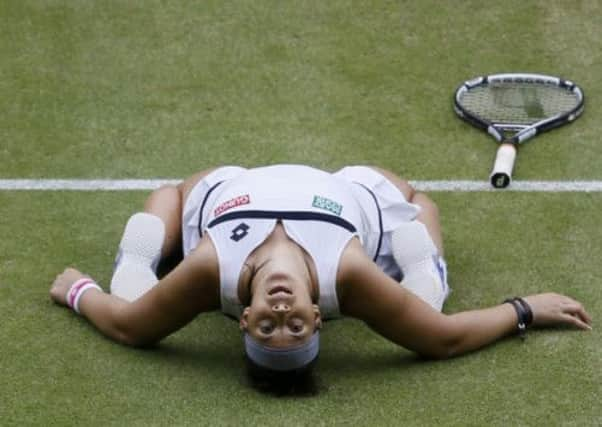Wimbledon: Bartoli into second SW19 final


Certainly, the Frenchwoman did not have to be close to her best against Kirsten Flipkens yesterday, beating the Belgian 6-1, 6-2 to book a place in tomorrow’s final against Sabine Lisicki. But Bartoli nonetheless displayed the fierce competitive spirit which will give her a chance against the German.
It was all too much in 2007. Bartoli, just 21 at the time, won a three-set semi-final against Justine Henin in the presence of one of her heroes, Pierce Brosnan. The former James Bond was unable to attend the final, which Bartoli lost in straight sets to Venus Williams, but his absence was not the real reason for her 6-4, 6-1 defeat: her inability to play her best was.
Advertisement
Hide AdAdvertisement
Hide AdIt is a problem which Bartoli, the No 15 seed this year, has always faced. She plays with extreme intensity, and a commitment to every point achieved by regular bouts of tennis’s equivalent of shadow boxing. But, when she loses concentration, the emotional energy she puts into matches can tell against her. Flipkens, at 5ft a slighter, lighter woman, knew she would have to knock Bartoli off kilter if she was to have a chance. But, troubled by a knee injury which required a medical timeout in the second set, the Belgian could do little more than defend defiantly for a time before giving in to the inevitable.
Like Tim Henman, Flipkens is a decent all-rounder who lacks one massive weapon. To win against the top players, she needs to have every department of her game functioning at seven or eight out of ten. Yesterday, she hardly rated pass marks in any department except her sliced backhands.
Flipkens served seven times in the match and held only once in each set, her other game coming when she broke Bartoli to close to 3-1 and briefly threaten a second-set comeback. But, although disappointed to have been unable to contribute more to the occasion, the 27-year-old was able to look back on a run to the last four that would have been inconceivable a little over a year ago, when she was forced to rest for months after blood clots were discovered in her legs. “I think the semis was the maximum I could got to this year,” the No 20 seed admitted. “I mean, I had to play, I don’t know, 500 per cent I think to beat Marion today. She was just too good. To have this memory for the rest of my life, ten years after winning the juniors title here, is great. I mean, I would have signed for that before my career, for sure.”
Just like her compatriot Justine Henin, Flipkens’s lack of stature means she has to be a counterpuncher. And the restricted mobility caused by the knee injury meant she was unable to perform that part of her game properly – although she accepted that even if fully fit she would not have beaten Bartoli on the form the Frenchwoman was showing. “First of all, I’m not going to use it [the injury] as an excuse, that’s for sure. I mean, Marion played an amazing, good match. But I fell in the first set, on my bad knee. At that moment I didn’t feel it, but a couple of games later I started to feel a really sharp pain. I’m really trying to handle it already for four weeks. I’m already playing with the tape so long. It definitely needs a rest.”
The knee held out in the quarter-finals against Petra Kvitova, but the former champion wobbled badly in a way that Bartoli never did. Bartoli’s service action and manic behaviour looks more like a French cartoonist’s idea of how a tennis player should move than anything you would learn from a coaching manual.
Her preparation for matches is a little unusual too, as she has the ability to snooze until shortly before she is due on court. For yesterday’s 1pm start that meant a nap until around 12.30pm. “I felt I was maybe a bit tired and I needed a quick nap just to recover from my early-morning practice and everything I had to do to be ready,” she said. “So it was just a quick nap of 15, 20 minutes and go on court. But so far it’s working extremely well, so I don’t see why I should change that.”
Bartoli’s routine between points can distract opponents, but she insisted that she had established it long before she had any thoughts of how to psych out the person on the other side of the net. “Actually, I’ve been doing that forever,” she said. “I have some tapes of myself when I was six or seven years old and I was still doing the same. It’s just part of me. It’s just a great way for me to focus on the next point, focus on what I need to do, not thinking about this court, the occasion, the breakpoint, the game point, whatever. Just trying to be ready for what’s coming. It’s not like I want to annoy my opponent. It’s really me trying to be ready for the point that is coming out.”
That routine may be the same, but so many other aspects of Bartoli’s game have improved since her last final. This time she can do it, no matter who is – or is not – in the crowd.